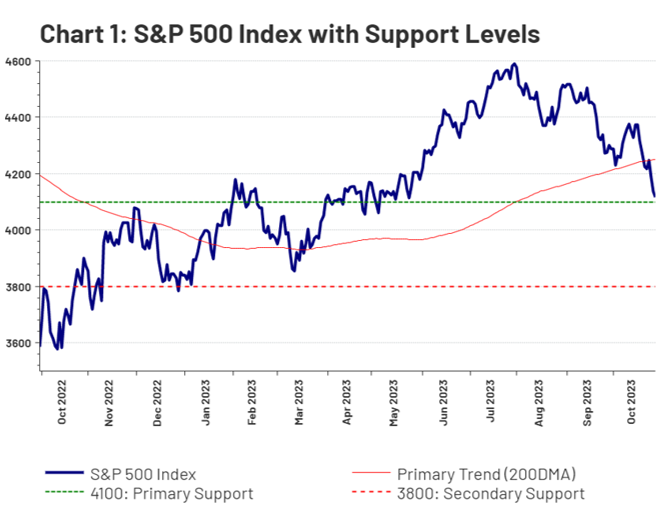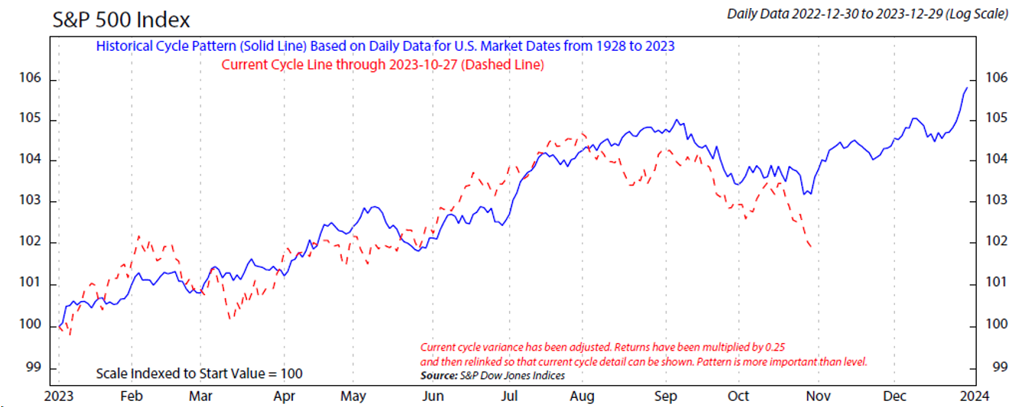By Chris Konstantinos
SUMMARY
- US market is now officially in a ‘correction’.
- We see reasons for optimism into year-end…
- …due to strength in the economy and earnings, plus seasonal patterns.
Reasons for Optimism
What Happened Last Week?
At the risk of making a cheesy Halloween pun, last week was ‘all trick and no treat’ for investors, as markets were spooked by continued interest rate volatility, geopolitical concerns, and a US earnings season which has gotten off to an uneven start. As of Friday, the S&P 500 has now pulled back -10% from its cycle high made in July- the definition of a ‘market correction’ – for the first time since the rally started roughly a year ago (Chart 1, below). While the near term may remain dicey, we are starting to see an improving reward relative to risk for both stocks and bonds heading into the end of the year.
US Stocks: Pervasive Pessimism, Favorable Seasonality and Earnings Resilience Gives Us Hope
Technicals – Near-term Support Broken, Watching 4100: From a technical perspective, meaningful support levels were breached last week, with the S&P falling below 4200 and the 10-year yield flirting with 5%. Despite this breach, we are not ready yet to further reduce equity exposure in our balanced portfolios, as we are gauging the magnitude and duration of this pullback to determine if the breakdown is decisive and sustainable.

Source: LSEG Datastream, RiverFront. Data daily through October 27, 2023. Chart shown for illustrative purposes. Past performance is no guarantee of future results. An investment cannot be made directly in an index.
We view the next support level at around 4100 (Chart 1, green dotted line), which represents a roughly 2/3 retracement of the recent rally from the March 2023 low, as well as what we view as a zone of meaningful consolidation last April and May. A decisive break below that zone would imply a retest of the March low of around 3800 (see Chart 1, red dotted line).
Historical Analysis Suggests Positive Near-Term Returns into End of the Year: It’s worth noting that two of RiverFront’s ‘Three Tactical Rules’ – ‘Don’t Fight the Trend’ and ‘Beware the Crowd at Extremes’ are still in investors’ favor for US markets (see more in our Weekly View from October 2nd). From the perspective of ‘Don’t Fight the Trend’, the slope of the S&P 500’s primary trend (as defined by the 200-day moving average, Chart 1 above, red solid upward sloping line), has decelerated but should remain positive for the foreseeable future. With crowd sentiment bearish, RiverFront’s proprietary ‘heatmap’ analysis (which combines primary trend slope and sentiment data to gauge market probabilities based on history), is still suggesting to us a higher-than-average probability of positive market returns over the next 3 months.
This analysis is supported by seasonal patterns. September historically tends to be the weakest market return month, October is often a month where the market bottoms and December tends to be the strongest, giving rise to the concept of the ‘Santa Claus’ rally. So far this year, the S&P has tracked its 95-year historical seasonal pattern relatively closely going back to 1928, according to data from Ned Davis Research (NDR). If history is any guide, this year’s ‘Santa Claus’ rally could start in earnest soon (see NDR chart, below). Some potential catalysts for strength into year-end include continued positive economic and earnings performance, body language from the Fed that the end of the hiking cycle is near, and/or if the war in Gaza does not spread to a wider regional conflict, as we currently expect (see more in our Weekly View from October 24th).
Chart 2: Seasonality Could Help S&P 500 Returns Into the End of the Year

Copyright 2023 Ned Davis Research, Inc. Further distribution prohibited without prior permission. All Rights Reserved. See NDR Disclaimer at ndr.com/copyright.html. For data vendor disclaimers refer to ndr.com/vendorinfo/. Past performance is no guarantee of future results. Shown for illustrative purposes.
Stock Fundamentals: Stronger than Commonly Appreciated, in our View
We believe stock market fundamentals are also generally better than currently appreciated by the market. More specifically:
- The US economy remains in expansion: The US economy shocked many economic bears by putting up an impressive +4.9% real GDP growth rate for the third quarter. This strength was led by resiliency in consumers; Personal consumption spending – which represents approximately 69% of US GDP- was up almost +4% quarter over quarter, contributing 2.7 percentage points to GDP. Spending on durable goods was up +4.7% month over month in September, suggesting to us a pickup in capital expenditures during Q4. While the downside of this is that the Fed will likely keep interest rates ‘higher for longer’, longer-term interest rates have already reflected this view in our opinion.
- Earnings season thus far has been better than average: While there have been several high-profile earnings misses thus far in the Q3 earnings season, the overall performance of companies has been generally solid, in our opinion. With roughly half of S&P 500 companies having reported, about 56% of reporting companies have earnings that have ‘beat’ their Q3 estimate from six months ago. If this holds through the remainder of the earnings seasons, it will represent the highest beat percentage in the last six quarters (source: Factset, RiverFront Investment Group).
US Fixed Income – Improving Picture: We Believe Yields Will Remain Close to 5%
In our view, we are now getting to levels in the bond market where investors may need to begin to rethink asset allocation decisions, as fixed income is becoming increasingly attractive in comparison to equities on a risk-adjusted basis. With the 10-year Treasury yielding 4.9% and the S&P500’s dividend yield at 1.7%, the 3.2% percentage point differential is compelling in our view, especially for investors needing income.
We expect the long end of the yield curve to start to anchor around 5% as investors begin to lock in higher yields. We see the recent back-up in yields as an opportunity to shift more money to fixed income, taking more interest rate risk, less credit risk and generally lowering portfolio volatility over longer timeframes due to the cushion of greater income. This is especially true for investors in the ‘distribute’ phase of their investment journey. Furthermore, investment grade corporate bond spreads are now 1.3 percentage points above equivalent maturity Treasuries, yielding 6.34%. The sector continues to show no signs of any credit issues, as companies have adapted their operating strategies to reduce costs and overall leverage.
Conclusion
We still believe that the US economy – and corporate earnings – will prove resilient, stocks will survive the current pullback, and bond yields will anchor around 5%. Pervasive pessimism, along with a still-positive technical trend and favorable seasonal patterns kicking in, reinforces our belief that it’s too early to give up on the stock bull market. We continue to prefer US stocks over international and favor the investment themes of large-cap, high-cash flow technology and energy companies. We are also advocating for alternative yield strategies that can help generate additional income in volatile markets, in keeping with our PATTY (‘Pay Attention to the Yield’) theme.
Risk Discussion: All investments in securities, including the strategies discussed above, include a risk of loss of principal (invested amount) and any profits that have not been realized. Markets fluctuate substantially over time, and have experienced increased volatility in recent years due to global and domestic economic events. Performance of any investment is not guaranteed. In a rising interest rate environment, the value of fixed-income securities generally declines. Diversification does not guarantee a profit or protect against a loss. Investments in international and emerging markets securities include exposure to risks such as currency fluctuations, foreign taxes and regulations, and the potential for illiquid markets and political instability. Please see the end of this publication for more disclosures.
Important Disclosure Information:
The comments above refer generally to financial markets and not RiverFront portfolios or any related performance. Opinions expressed are current as of the date shown and are subject to change. Past performance is not indicative of future results and diversification does not ensure a profit or protect against loss. All investments carry some level of risk, including loss of principal. An investment cannot be made directly in an index.
Information or data shown or used in this material was received from sources believed to be reliable, but accuracy is not guaranteed.
This report does not provide recipients with information or advice that is sufficient on which to base an investment decision. This report does not take into account the specific investment objectives, financial situation or need of any particular client and may not be suitable for all types of investors. Recipients should consider the contents of this report as a single factor in making an investment decision. Additional fundamental and other analyses would be required to make an investment decision about any individual security identified in this report.
Chartered Financial Analyst is a professional designation given by the CFA Institute (formerly AIMR) that measures the competence and integrity of financial analysts. Candidates are required to pass three levels of exams covering areas such as accounting, economics, ethics, money management and security analysis. Four years of investment/financial career experience are required before one can become a CFA charterholder. Enrollees in the program must hold a bachelor’s degree.
All charts shown for illustrative purposes only. Technical analysis is based on the study of historical price movements and past trend patterns. There are no assurances that movements or trends can or will be duplicated in the future.
Ned Davis Research (NDR) is a global provider of independent investment research, solutions, and tools. Founded in 1980, NDR helps clients around the world make objective investment decisions.
Principal Risks:
Stocks represent partial ownership of a corporation. If the corporation does well, its value increases, and investors share in the appreciation. However, if it goes bankrupt, or performs poorly, investors can lose their entire initial investment (i.e., the stock price can go to zero). Bonds represent a loan made by an investor to a corporation or government. As such, the investor gets a guaranteed interest rate for a specific period of time and expects to get their original investment back at the end of that time period, along with the interest earned. Investment risk is repayment of the principal (amount invested). In the event of a bankruptcy or other corporate disruption, bonds are senior to stocks. Investors should be aware of these differences prior to investing.
In general, the bond market is volatile, and fixed income securities carry interest rate risk. (As interest rates rise, bond prices usually fall, and vice versa). This effect is usually more pronounced for longer-term securities). Fixed income securities also carry inflation risk, liquidity risk, call risk and credit and default risks for both issuers and counterparties. Lower-quality fixed income securities involve greater risk of default or price changes due to potential changes in the credit quality of the issuer. Foreign investments involve greater risks than U.S. investments, and can decline significantly in response to adverse issuer, political, regulatory, market, and economic risks. Any fixed-income security sold or redeemed prior to maturity may be subject to loss.
Investing in foreign companies poses additional risks since political and economic events unique to a country or region may affect those markets and their issuers. In addition to such general international risks, the portfolio may also be exposed to currency fluctuation risks and emerging markets risks as described further below.
Changes in the value of foreign currencies compared to the U.S. dollar may affect (positively or negatively) the value of the portfolio’s investments. Such currency movements may occur separately from, and/or in response to, events that do not otherwise affect the value of the security in the issuer’s home country. Also, the value of the portfolio may be influenced by currency exchange control regulations. The currencies of emerging market countries may experience significant declines against the U.S. dollar, and devaluation may occur subsequent to investments in these currencies by the portfolio.
Foreign investments, especially investments in emerging markets, can be riskier and more volatile than investments in the U.S. and are considered speculative and subject to heightened risks in addition to the general risks of investing in non-U.S. securities. Also, inflation and rapid fluctuations in inflation rates have had, and may continue to have, negative effects on the economies and securities markets of certain emerging market countries.
Technology and internet-related stocks, especially of smaller, less-seasoned companies, tend to be more volatile than the overall market.
Index Definitions:
Standard & Poor’s (S&P) 500 Index measures the performance of 500 large cap stocks, which together represent about 80% of the total US equities market.
Definitions:
The 200-day moving average is a popular technical indicator which investors use to analyze price trends. It is simply a security’s average closing price over the last 200 days.
Don’t Fight the Fed – ‘Supportive’ means the Fed’s monetary policy regarding inflation and employment is in what we believe based on our analysis to be the investors’ best interest; ‘Against’ means the Fed’s monetary policy, in our view, is going against the investors’ best interest; ‘Neutral’ means the Fed’s monetary policy is neither supportive or against the investors’ best interest in our view. Don’t Fight the Trend – Terms correlate to the 200-day moving average as it relates to the equity indexes: ‘Positive’ means that the trend is rising, ‘Flat’ means the trend is flat, ‘Negative’ means the trend is falling. Beware the Crowd at Extremes – Terms correlate to the NDR Crowd Sentiment Poll and its measurement of Extreme Optimism (Bearish), Neutral, or Extreme Pessimism (Bullish).
RiverFront Investment Group, LLC (“RiverFront”), is a registered investment adviser with the Securities and Exchange Commission. Registration as an investment adviser does not imply any level of skill or expertise. Any discussion of specific securities is provided for informational purposes only and should not be deemed as investment advice or a recommendation to buy or sell any individual security mentioned. RiverFront is affiliated with Robert W. Baird & Co. Incorporated (“Baird”), member FINRA/SIPC, from its minority ownership interest in RiverFront. RiverFront is owned primarily by its employees through RiverFront Investment Holding Group, LLC, the holding company for RiverFront. Baird Financial Corporation (BFC) is a minority owner of RiverFront Investment Holding Group, LLC and therefore an indirect owner of RiverFront. BFC is the parent company of Robert W. Baird & Co. Incorporated, a registered broker/dealer and investment adviser.
To review other risks and more information about RiverFront, please visit the website at riverfrontig.com and the Form ADV, Part 2A. Copyright ©2023 RiverFront Investment Group. All Rights Reserved. ID 3200042
For more news, information, and analysis, visit the ETF Strategist Channel.

